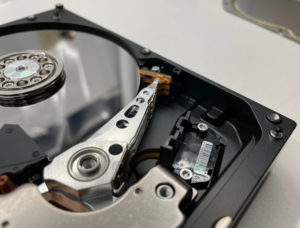 Hard drives aren’t going anywhere anytime soon — at least, in enterprise applications. Data centers need inexpensive, reliable storage, and hard disk drives (HDD) provide that value.
Hard drives aren’t going anywhere anytime soon — at least, in enterprise applications. Data centers need inexpensive, reliable storage, and hard disk drives (HDD) provide that value.
But that doesn’t mean that speed isn’t important. While hard drives continue to offer unparalleled storage capacity at a cost-effective price point, their performance — especially in terms of input/output operations per second (IOPS) — has lagged behind the demands of modern data-intensive applications.
In previous articles, we’ve discussed how heat-assisted magnetic recording (HAMR) and shingled magnetic recording (SMR) have allowed for greater areal densities. Today, we’re looking at another aspect of hard drive technology that’s primed for innovation: the actuator.
To discuss data recovery solutions for multi-actuator hard drives, call 1-800-237-4200 or submit a case online.
How Multi-Actuator Hard Drives Improve Performance
Conventional hard drives rely on a single actuator arm to control the movement of the read/write heads across the spinning platters. This sequential access mechanism creates a bottleneck, limiting the number of IOPS the drive can handle and hindering overall performance, particularly in scenarios requiring simultaneous access to multiple data locations.
Multi-actuator technology overcomes this limitation by — you guessed it — by incorporating multiple independent actuators within a single hard drive. Each actuator controls its own set of read/write heads, which enables parallel data access and dramatically boosts performance.
With two or more actuators working in concert, the drive can execute multiple read/write operations simultaneously, accessing data from different areas of the platters concurrently.
Related: Heat-Assisted Magnetic Recording: The Future of Hard Drive Technology?
Multiple Actuators Means Faster IOPS and Read/Write Speeds
The immediate benefit of this parallelism is a substantial increase in IOPS. With two actuators, a hard drive can theoretically double its IOPS, as two sets of heads can independently read or write data. Note that this is theoretical — in reality, data organization plays a significant role in the speed increase.
But even in practical applications, multiple actuators means faster response times, reduced latency, and improved overall system performance in demanding applications like databases, virtual machines, and cloud storage.
Real-World Impact: Multi-Actuator Hard Drives vs. SSDs
Multi-actuator hard drives are already commercially available. Seagate’s MACH.2 platform utilizes two actuators, and their Exos 2X14 MACH.2 enterprise hard drive delivers a sustained data transfer rate of 524MB/s, significantly outperforming traditional single-actuator drives.
So, does that mean that multi-actuator hard drives are headed for the shelves of your local electronics store? Not quite.
While multi-actuator drives offer a significant performance boost over traditional hard drives, they still can’t quite match the raw speed of solid-state drives (SSDs). SSDs don’t have moving parts, and they excel at random access.
With that said, multi-actuator drives close the gap considerably, especially in scenarios involving sequential data access. Plus, they offer a significant advantage in terms of cost per gigabyte.
But for most consumers, SSDs are a preferable option; like HAMR and SMR hard drives, multi-actuator drives are best suited for high-performance, low-cost applications.
Related: Thanks to AI, Hard Drives Aren’t Going Anywhere
Reliability of Multi-Actuator Hard Drives
Currently, we don’t have enough data to compare the reliability of dual-actuator and single-actuator hard drives.
There are a few factors to consider:
- Complexity – Multi-actuator drives inherently have more moving parts and intricate control mechanisms compared to their single-actuator counterparts. This could potentially increase the risk of component failure.
- Redundancy – However, the presence of multiple actuators also introduces a degree of redundancy. If one actuator fails, the drive might still function, albeit with reduced performance, as the remaining actuator can continue handling data access.
- Manufacturer Testing – Seagate claims that their dual-actuator drives maintain the same high reliability standards as their single-actuator counterparts. They claim a Mean Time Between Failures (MTBF) of 2.5 million hours for their Exos 2X14 MACH.2 drives, comparable to other enterprise-grade hard drives.
As the technology matures and more data becomes available, we’ll get a clearer picture of the long-term reliability (and the practicality of multi-actuator platforms).
Data Recovery for Multi-Actuator Hard Drives
Multi-actuator hard drives present unique challenges for data recovery engineers. The presence of multiple actuators does not significantly decrease the chances of a successful data recovery attempt, nor does it significantly change the process for drive evaluation and repair.
However, data recovery from dual-actuator drives often necessitates a deep understanding of RAID configurations and server databases, along with access to specialized tools for drive and firmware repair.
At Datarecovery.com, we’re committed to staying at the forefront of data recovery technology. We’re actively investing in research and development to ensure we maintain our high success rates as storage technologies evolve.
If you encounter data loss on a multi-actuator hard drive, we’re here to help. Contact us at 1-800-237-4200 or submit a case online for a free evaluation.




